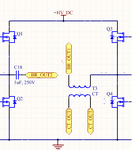renga92
Member level 5
Hi. I am trying to make an AC current transformer which can measure up to +/- 6A. At +/- 6A it should give an output of 1.2V. I simulated the circuit as given below in LTspice and it worked perfectly.

When implemented, it is not working as in simulation. Below is what I observed as waveform when probed at the output terminals.
![IMG_20160429_152840959[1].jpg IMG_20160429_152840959[1].jpg](https://www.edaboard.com/data/attachments/62/62312-84b99ac72d82ab378a075ce6301c8e77.jpg)
Input to the current transformer (T3) is one of the outputs of h bridge as shown in the figure before.

At no load condition[When the H bridge output is not connected to the isolation transformer], the current transformer output spikes when the MOSFET is triggered.
It should be 0 Amp across the current transformer but it is spiking as if there is a current across them.
The current transformer details are
Primary Inductance : 13.5 uH
Secondary Inductance : 7.25 mH
Switching frequency : 50Khz
Range : +/-6A
Could you help me figure out where the problem is ?
Thanks

When implemented, it is not working as in simulation. Below is what I observed as waveform when probed at the output terminals.
![IMG_20160429_152840959[1].jpg IMG_20160429_152840959[1].jpg](https://www.edaboard.com/data/attachments/62/62312-84b99ac72d82ab378a075ce6301c8e77.jpg)
Input to the current transformer (T3) is one of the outputs of h bridge as shown in the figure before.

At no load condition[When the H bridge output is not connected to the isolation transformer], the current transformer output spikes when the MOSFET is triggered.
It should be 0 Amp across the current transformer but it is spiking as if there is a current across them.
The current transformer details are
Primary Inductance : 13.5 uH
Secondary Inductance : 7.25 mH
Switching frequency : 50Khz
Range : +/-6A
Could you help me figure out where the problem is ?
Thanks